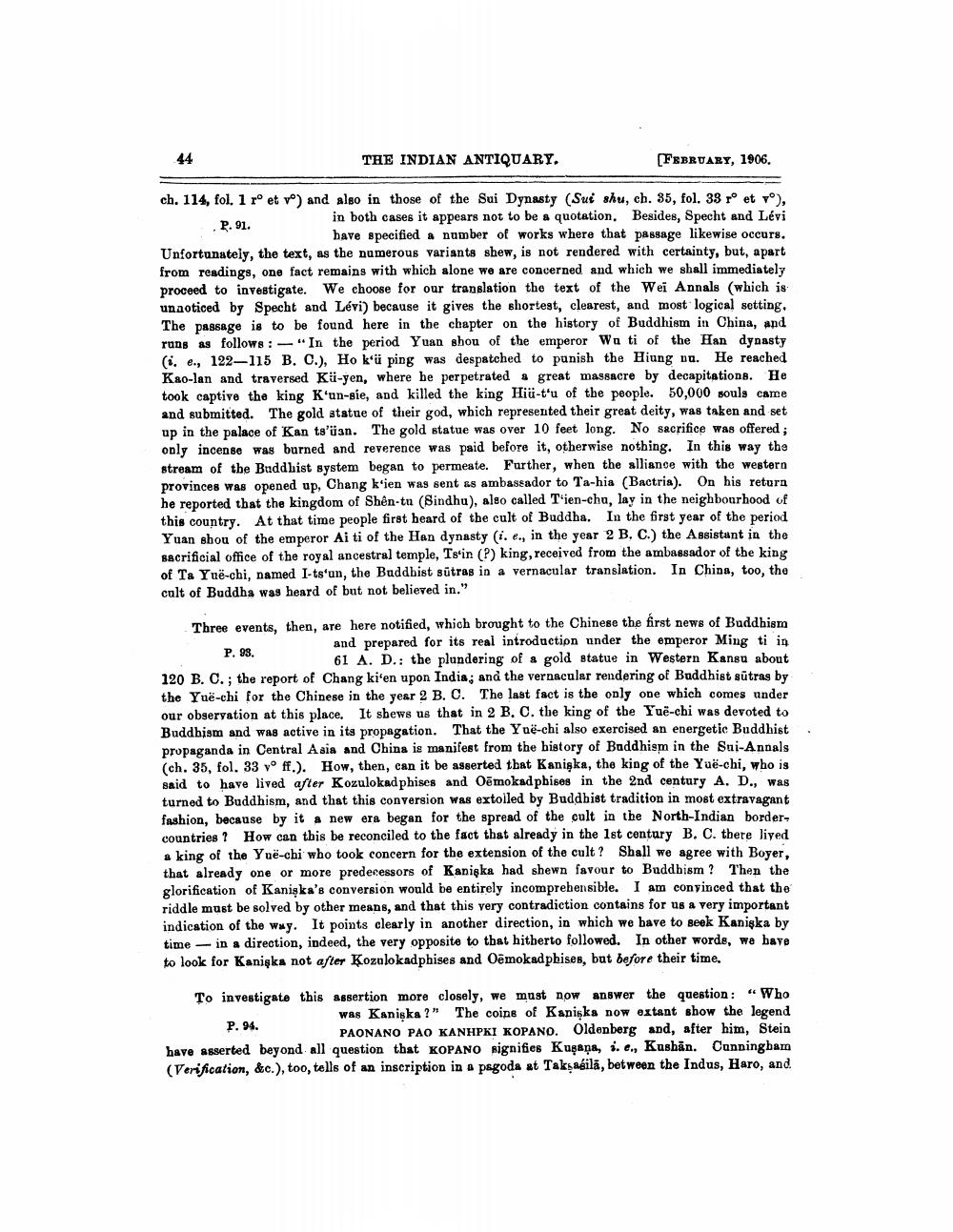________________
44
THE INDIAN ANTIQUARY.
[FEBRUARY, 1906.
ch. 114, fol. 1 ro et vo) and also in those of the Sui Dynasty (Sui shu, ch. 35, fol. 33 ro et ro), R. 91.
in both cases it appears not to be a quotation. Besides, Specht and Lévi
have specified number of works where that passage likewise occurs. Unfortunately, the text, as the numerous variants shew, is not rendered with certainty, but, apart from readings, one fact remains with which alone we are concerned and which we shall immediately proceed to investigate. We choose for our translation the text of the Wei Annals (which is unaoticed by Specht and Lévi) because it gives the shortest, clearest, and most logical setting. The passage is to be found here in the chapter on the history of Buddhism in China, and runs as follows: "In the period Yuan shou of the emperor Wa ti of the Han dynasty (i. e., 122-115 B. 0.), Ho k'ü ping was despatched to punish the Hiung nu. He reached Kao-lan and traversed Kli-yen, where he perpetrated a great massacre by decapitations. He took captive the king K'un-sie, and killed the king Hiü-t'u of the people. 50,000 souls came and submitted. The gold statue of their god, which represented their great deity, was taken and set up in the palace of Kan ts'üan. The gold statue was over 10 feet long. No sacrifice was offered ; only incense was burned and reverence was paid before it, otherwise nothing. In this way the stream of the Buddhist system began to permeate. Further, when the alliance with the western provinces was opened up, Chang k‘ien was sent as ambassador to Ta-hia (Bactria). On his return he reported that the kingdom of Shên-tu (Sindhu), aleo called T'ien-chu, lay in the neighbourhood of this country. At that time people first heard of the cult of Buddha. In the first year of the period Yuan shou of the emperor Ai ti of the Han dynasty i.e., in the year 2 B. C.) the Assistant in the sacrificial office of the royal ancestral temple, Ts in (?) king, received from the ambassador of the king of Ta Ynë-chi, named I-ts'un, the Buddhist sūtras in a vernacular translation. In China, too, the cult of Buddha was heard of but not believed in."
Three events, then, are here notified, which brought to the Chinese the first news of Buddhism
and prepared for its real introduction under the emperor Ming ti in
61 A. D.: the plundering of a gold statue in Western Kansu about 120 B. C. ; the report of Chang kifen upon India, and the vernaculer rendering of Buddhist sūtras by the Yuë-chi for the Chinese in the year 2 B. C. The last fact is the only one which comes under our observation at this place. It shews us that in 2 B. C. the king of the Yue-chi was devoted to Buddhism and was active in its propagation. That the Yue-chi also exercised an energetic Buddhist propaganda in Central Asia and China is manifest from the history of Buddhism in the Sui Annals (ch. 35, fol. 33 vo ff.). How, then, can it be asserted that Kaniska, the king of the Yuë-chi, who is said to have lived after Kozulokadphises and Oēmokad pbises in the 2nd century A. D., was turned to Buddhism, and that this conversion was extoiled by Buddhist tradition in most extravagant fashion, because by it a new era began for the spread of the cult in the North-Indian bordercountries? How can this be reconciled to the fact that already in the 1st century B. C. there lived a king of the Yue-chi who took concern for the extension of the cult? Shall we agree with Boyer, that already one or more predecessors of Kanişka had shewn favour to Buddhism ? Then the glorification of Kanişka's conversion would be entirely incomprehensible. I am convinced that the riddle must be solved by other means, and that this very contradiction contains for us a very important indication of the way. It points clearly in another direction, in which we have to seek Kaniska by time in a direction, indeed, the very opposite to that hitherto followed. In other words, we have to look for Kaninka not after ķozolokadphises and Oēmokad pbises, but before their time,
To investigate this assertion more closely, we must now answer the question: "Who
was Kaniska?" The coins of Kanisks now extant show the legend P. 94.
PAONANO PAO KANHPKI KOPANO. Oldenberg and, after him, Stein have asserted beyond all question that KOPANO signifies Kuşaņa, i. e., Kushăn. Cunningham (Verification, &c.), too, tells of an inscription in a pagoda at Tak agilā, between the Indus, Haro, and




